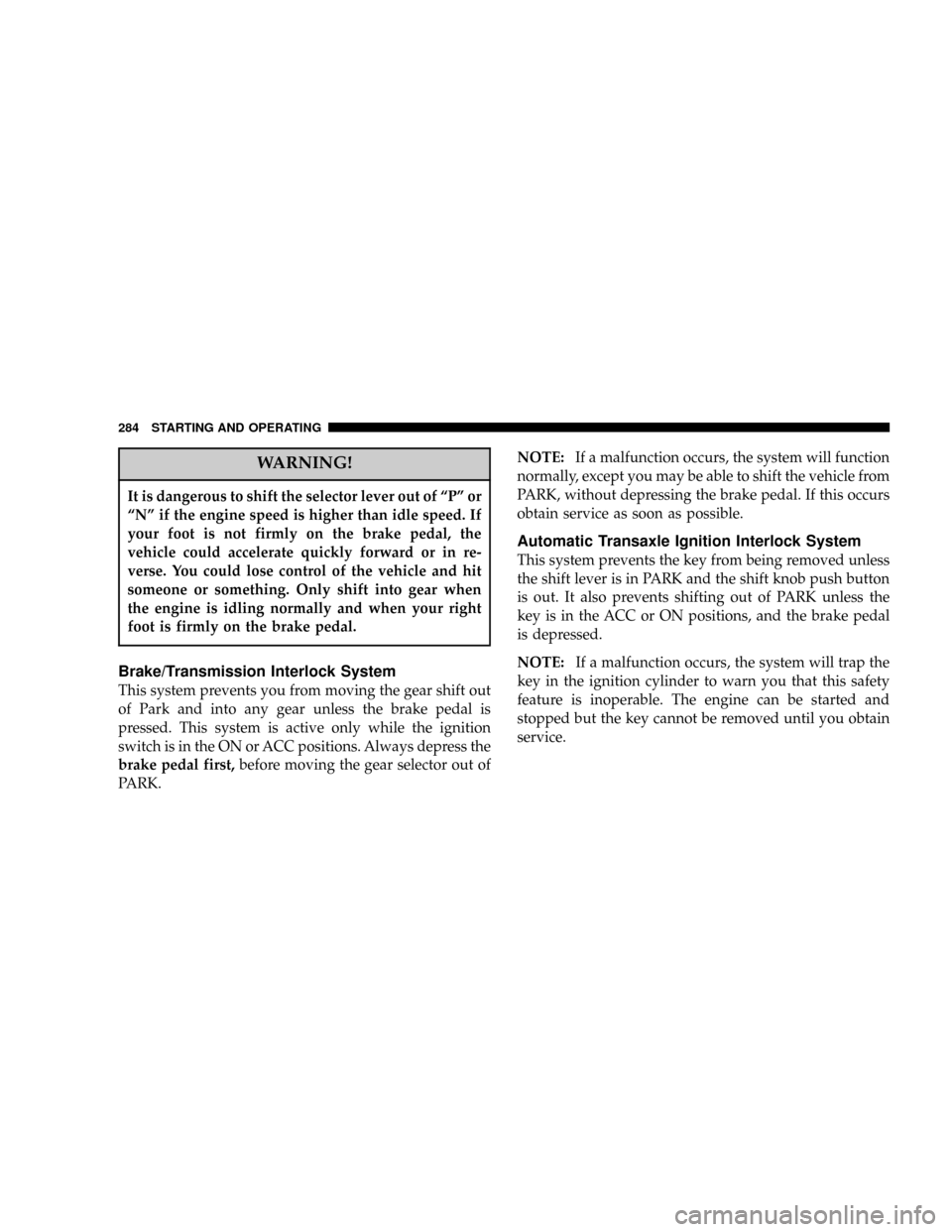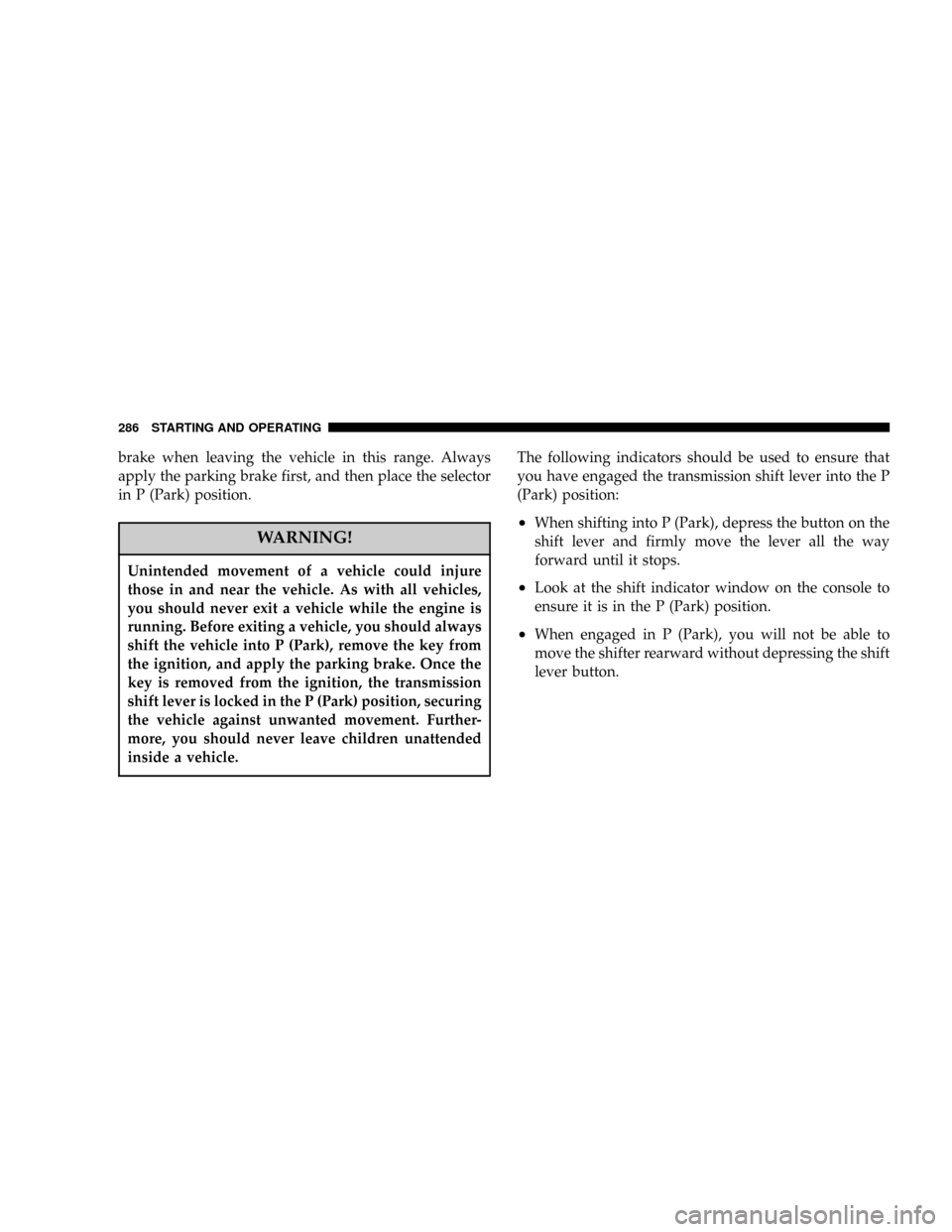start stop button CHRYSLER PT CRUISER 2007 1.G Owners Manual
[x] Cancel search | Manufacturer: CHRYSLER, Model Year: 2007, Model line: PT CRUISER, Model: CHRYSLER PT CRUISER 2007 1.GPages: 467, PDF Size: 7.57 MB
Page 108 of 467

into the retractor, as the belt retracts, you will hear a
clicking sound. This indicates that the seat belt is now in
the automatic locking mode. Pull on the excess webbing
to tighten the lap portion about the child restraint. Follow
the instructions of the child restraint manufacture.
NOTE:To reset this feature you must let all of the belt
webbing return into the retractor. You will not be able to
pull out more webbing until all of the webbing has been
returned back into the retractor.
²In the rear seat, you may have trouble tightening the
lap/shoulder belt on the child restraint because the
buckle or latch plate is too close to the belt path
opening on the restraint. Disconnect the latch plate
from the buckle and twist the short buckle end of the
belt several times to shorten it. Insert the latch plate
into the buckle with the release button facing out.
²If the belt still can't be tightened, or if by pulling and
pushing on the restraint loosens the belt, disconnectthe latch plate from the buckle, turn the latch plate
around, and insert the latch plate into the buckle
again. If you still can't make the child restraint secure,
try a different seating position.
²Buckle the child into the seat according to the child
restraint manufacturer's directions.
²When your child restraint is not in use, secure it in the
vehicle with the seat belt or remove it from the vehicle.
Don't leave it loose in the vehicle. In a sudden stop or
collision, it could strike the occupants or seat backs
and cause serious personal injury.
Lower Anchors and Tether for CHildren (LATCH)
Your vehicle is equipped with the child restraint anchor-
age system called LATCH, which stands for Lower
Anchors and Tether for CHildren. The LATCH system
provides for the installation of the child restraint without
using the vehicle seat belt. Both rear seating positions
have exclusive lower anchorages located at the rear of the
108 THINGS TO KNOW BEFORE STARTING YOUR VEHICLE
Page 230 of 467

turned from the OFF to the ON position, and the light
will turn off after the engine is started. If the bulb does
not come on during starting, have the system checked by
an authorized dealer.
If the light comes on and remains on while driving, stop
the vehicle and shut off the engine. DO NOT OPERATE
THE VEHICLE UNTIL THE CAUSE IS CORRECTED.
The light does not show the quantity of oil in the engine.
This can be determined using the procedure shown in
Section 7. (See page 368 for more information.)
22. High Beam Indicator
This light shows that the headlights are on high
beam. Pull the turn signal lever toward the steer-
ing wheel to switch the headlights from high or low
beam.23. Electronic Vehicle Information Center DisplayÐIf
Equipped
When the appropriate conditions exist, this display
shows the Electronic Vehicle Information Center (EVIC)
messages. (See page 231 for more information.)
24. Odometer/Trip Odometer Reset Knob
Press this button to change the display from odometer to
either of the two trip odometer settings. Trip A or Trip B
will appear when in the trip odometer mode. Push in and
hold the button for two seconds to reset the trip odometer
to 0 miles or kilometers. The odometer must be in trip
mode to reset.
25. Electronic Vehicle Information Center (EVIC)
ButtonÐIf Equipped
Pushing this button will switch between the different
EVIC functions. (See page 231 for more information.)
230 UNDERSTANDING YOUR INSTRUMENT PANEL
Page 284 of 467

WARNING!
It is dangerous to shift the selector lever out of ªPº or
ªNº if the engine speed is higher than idle speed. If
your foot is not firmly on the brake pedal, the
vehicle could accelerate quickly forward or in re-
verse. You could lose control of the vehicle and hit
someone or something. Only shift into gear when
the engine is idling normally and when your right
foot is firmly on the brake pedal.
Brake/Transmission Interlock System
This system prevents you from moving the gear shift out
of Park and into any gear unless the brake pedal is
pressed. This system is active only while the ignition
switch is in the ON or ACC positions. Always depress the
brake pedal first,before moving the gear selector out of
PARK.NOTE:If a malfunction occurs, the system will function
normally, except you may be able to shift the vehicle from
PARK, without depressing the brake pedal. If this occurs
obtain service as soon as possible.
Automatic Transaxle Ignition Interlock System
This system prevents the key from being removed unless
the shift lever is in PARK and the shift knob push button
is out. It also prevents shifting out of PARK unless the
key is in the ACC or ON positions, and the brake pedal
is depressed.
NOTE:If a malfunction occurs, the system will trap the
key in the ignition cylinder to warn you that this safety
feature is inoperable. The engine can be started and
stopped but the key cannot be removed until you obtain
service.
284 STARTING AND OPERATING
Page 286 of 467

brake when leaving the vehicle in this range. Always
apply the parking brake first, and then place the selector
in P (Park) position.
WARNING!
Unintended movement of a vehicle could injure
those in and near the vehicle. As with all vehicles,
you should never exit a vehicle while the engine is
running. Before exiting a vehicle, you should always
shift the vehicle into P (Park), remove the key from
the ignition, and apply the parking brake. Once the
key is removed from the ignition, the transmission
shift lever is locked in the P (Park) position, securing
the vehicle against unwanted movement. Further-
more, you should never leave children unattended
inside a vehicle.
The following indicators should be used to ensure that
you have engaged the transmission shift lever into the P
(Park) position:
²When shifting into P (Park), depress the button on the
shift lever and firmly move the lever all the way
forward until it stops.
²Look at the shift indicator window on the console to
ensure it is in the P (Park) position.
²When engaged in P (Park), you will not be able to
move the shifter rearward without depressing the shift
lever button.
286 STARTING AND OPERATING
Page 294 of 467

PARKING BRAKE
When the parking brake is applied with the
ignition on, the Brake Light in the instrument
cluster will come on.
NOTE:This light only shows that the parking brake is
on. It does not show the degree of brake application.
If the parking brake is applied while the vehicle is
moving, a chime will sound to alert the driver. The chime
will sound up to 10 times or until the vehicle has
returned to a stop.
Before leaving the vehicle, make sure that the parking
brake is set. To set the parking brake, pull up firmly on
the lever. Also place the gear selector in the Park position
(automatic transaxle) or Reverse (manual transaxle). To
release the parking brake, apply the brake pedal, pull upslightly on the lever, then depress the button on the end
of the lever and push the lever fully down toward the
floor.
NOTE:The parking brake lever will not release unless
the lever is pulled up slightly past its applied position.
Parking Brake Lever
294 STARTING AND OPERATING
Page 467 of 467

INTRODUCTION INTRODUCTION HOW TO USE THIS MANUAL WARNINGS AND CAUTIONS VEHICLE IDENTIFICATION NUMBER VEHICLE MODIFICATIONS/ALTERATIONS THINGS TO KNOW BEFORE STARTING YOUR VEHICLE A WORD ABOUT YOUR KEYS
Ignition Key Removal
Locking Doors With The KeyKey-In-Ignition ReminderSENTRY KEY - IF EQUIPPED Replacement KeysSentry Key ProgrammingGeneral InformationSTEERING WHEEL LOCK - IF EQUIPPED If You Wish To Manually Lock The Steering WheelTo Release The Steering Wheel
LockAutomatic Transaxle Ignition Interlock SystemDOOR LOCKS Manual Door LocksPower Door LocksChild-Protection Door Lock System (Rear Doors) - IfEquippedREMOTE KEYLESS ENTRY (SEDAN) To unlock the doors and liftgateTo lock the doors and liftgate (if
equipped with power options) Using The Panic AlarmTo Turn Off Flash Lights With LockProgramming Additional TransmittersGeneral InformationBattery ReplacementREMOTE KEYLESS ENTRY (CONVERTIBLE) To Unlock the DoorsTo lock the doorsTo Unlatch the Deck
LidPanic AlarmUsing The Panic AlarmTo Turn Off Flash Lights With LockTo Program Additional TransmittersGeneral InformationTransmitter Battery ServiceSECURITY ALARM SYSTEM - IF EQUIPPED To set the alarmTo disarm the systemSecurity System Manual Override
LIFTGATE (SEDAN) DECK LID (CONVERTIBLE) Power Deck Lid Release (Convertible)EMERGENCY SEAT BACK RELEASE (SEDAN) EMERGENCY DECK LID RELEASE LATCH (CONVERTIBLE) POWER WINDOWS Auto Down FeatureRear Window SwitchesWind
BuffetingOCCUPANT RESTRAINTS (SEDAN) Lap/Shoulder BeltsAdjustable Upper Shoulder Belt AnchorageLap/Shoulder Belt Untwisting ProcedureSeat Belt PretensionersEnhanced Seat Belt Reminder System (BeltAlert) Seat Belts And Pregnant WomenDriver and Front
Passenger Supplemental Restraint System (SRS) - AirbagChild RestraintOCCUPANT RESTRAINTS (CONVERTIBLE) Lap/Shoulder BeltsLap/Shoulder Belt Untwisting ProcedureSeat Belt PretensionersEnhanced Seat Belt Reminder System (BeltAlert) Seat Belts And
Pregnant WomenDriver and Front Passenger Supplemental Restraint System (SRS) - AirbagChild RestraintENGINE BREAK-IN RECOMMENDATIONS SAFETY TIPS Exhaust GasSafety Checks You Should Make Inside The VehiclePeriodic Safety Checks You Should Make
Outside The VehicleUNDERSTANDING THE FEATURES OF YOUR VEHICLE CONVERTIBLE TOP OPERATION To Lower The TopTo Raise The TopConvertible Top Boot Cover Installation-If EquippedConvertible Top Boot Cover Removal and StorageCONVERTIBLE TOP
MANUAL OVERRIDEMIRRORS Inside Day/Night Mirror - If EquippedOutside Mirror-Drivers SideOutside Mirror-Passengers SideElectric Remote-Control Mirrors - If EquippedIlluminated Vanity Mirrors - If EquippedSun Visor Sliding FeatureHANDS-FREE COMMUNICATION
(UConnect) - IF EQUIPPED OperationsPhone Call FeaturesUConnect System FeaturesAdvanced Phone ConnectivityThings You Should Know About Your UConnect SystemGeneral InformationSEATS Front Seat AdjustmentPower Seat Adjuster - If EquippedManual
Lumbar-If EquippedFolding Front Passenger Seat - If EquippedDrivers Seat Back Tilt-If EquippedPassenger Seat Back Tilt (Easy Entry System) (Convertible)Adjustable Head RestraintsHeated Seats - If EquippedFolding Rear Seat (Sedan)Folding Rear Seat (Convertible)
Tumbling Rear Seat (Sedan)Tumbling Rear Seat (Convertible)Rear Seat Removal (Sedan)TO OPEN AND CLOSE THE HOOD LIGHTS Map/Reading Lights (Sedan)Map/Reading Lights (Convertible)Multi-Function Control LeverHeadlights, Parking Lights, Instrument Panel
LightsDaytime Running Lights (DRL) - If EquippedLights-on ReminderFog Lights - If Equipped Turn Signals Highbeam/Lowbeam Select Switch Passing LightWINDSHIELD WIPERS AND WASHERS Windshield WashersMist Feature Windshield Wiper OperationIntermittent
Wiper SystemTILT STEERING COLUMN ELECTRONIC SPEED CONTROL - IF EQUIPPED To ActivateTo Set At A Desired SpeedTo DeactivateTo Resume SpeedTo Vary The Speed SettingManual TransaxleTo Accelerate For PassingGARAGE DOOR OPENER - IF
EQUIPPED Programming The Universal TransceiverRolling Code ProgrammingCanadian Programming/Gate ProgrammingOperationReprogramming A Single ButtonSecurityPOWER SUNROOF - IF EQUIPPED Express Open FeatureWind BuffetingSunroof Maintenance
ELECTRICAL POWER OUTLETS Electrical Outlet Use With Engine OffCONSOLE FEATURES STORAGE Center Console/Armrest Storage Bin Storage PocketsREAR SHELF PANEL- IF EQUIPPED Position 1 (Top)Position 2 (Middle)Position 3 (Floor)Position 4 (Vertical) Position 5 (table)ROOF LUGGAGE RACK - IF EQUIPPED REAR WINDOW FEATURES Electric Rear Window Defroster Rear Wiper/Washer Switch - If EquippedAdding Washer FluidUNDERSTANDING YOUR INSTRUMENT PANEL INSTRUMENT PANEL FEATURES
INSTRUMENT CLUSTER-BASE INSTRUMENT CLUSTER-PREMIUM INSTRUMENT CLUSTER-TURBO INSTRUMENT CLUSTER DESCRIPTIONS ELECTRONIC VEHICLE INFORMATIONCENTER (EVIC)-If Equipped EVIC Functions Compass/Temperature/Audio
Average Fuel EconomyDistance To Empty (DTE)Elapsed TimePersonal Settings (Customer Programmable Features)SETTING THE ANALOG CLOCK RADIO GENERAL INFORMATION Radio Broadcast SignalsTwo Types of SignalsElectrical DisturbancesAM Reception
FM ReceptionSALES CODE REF - AM/FM/CD (SINGLE DISC) RADIO WITH OPTIONAL SATELLITE RADIO AND HANDS FREE PHONE CAPABILITY Operating Instructions - Radio ModeOperation Instructions - CD ModeOperation Instructions - Auxiliary ModeOperating
Instructions - Hands Free Phone - If EquippedOperating Instructions - Satellite Radio - If EquippedSALES CODE RAQ - AM/FM/CD (6-DISC) RADIO WITH OPTIONAL SATELLITE RADIO, HANDS FREE PHONE, AND VEHICLE ENTERTAINMENT SYSTEMS (VES)
CAPABILITIES Operating Instructions - Radio ModeOperation Instructions - (CD MODE for CD Audio Play)LOAD/EJECT Button (CD Mode for CD Audio Play)Notes On Playing MP3 FilesOperation Instructions - (CD Mode for MP3 Audio Play)LOAD/EJECT Button (CD Mode
for MP3 Play)SATELLITE RADIO - IF EQUIPPED System ActivationElectronic Serial Number/Sirius Identification Number (ESN/SID)Selecting Satellite Mode in REF, and RAQ, RadiosSelecting a ChannelStoring and Selecting Pre-Set ChannelsUsing the PTY (Program Type)
Button (if equipped)PTY Button SCANPTY Button SEEKSatellite AntennaReception QualityCD/DVD DISC MAINTENANCE RADIO OPERATION AND CELLULAR PHONES CLIMATE CONTROLS Climate ControlsOperating Tips STARTING AND OPERATING STARTING
PROCEDURES Automatic TransaxleManual TransaxleNormal StartingExtremely Cold Weather (below -20 degrees F or -29 degrees C)If Engine Fails to StartAfter StartingTurbocharger Cool DownAUTOMATIC TRANSAXLE - IF EQUIPPED Brake/Transmission Interlock
SystemAutomatic Transaxle Ignition Interlock SystemFour Speed Automatic TransaxleReset ModeGear Ranges For Four Speed Automatic TransaxleAUTOSTICK - IF EQUIPPED Autostick OperationAutostick General InformationMANUAL TRANSAXLE OPERATION 2.4
Liter Turbo- If Equipped Recommended Shift SpeedsDownshiftingPARKING BRAKE BRAKE SYSTEM Anti-Lock Brake System (ABS) - If EquippedPOWER STEERINGTRACTION CONTROL SYSTEM - IF EQUIPPED TIRE SAFETY INFORMATION Tire Markings Tire
Identification Number (TIN)Tire Loading and Tire PressureTIRES - GENERAL INFORMATION Tire PressureTire Inflation PressuresRadial-Ply TiresCompact Spare Tire - If EquippedLimited Use Spare - If EquippedTire SpinningTread Wear IndicatorsLife of TireReplacement
TiresAlignment And BalanceTIRE CHAINS SNOW TIRES Tire Rotation Recommendations FUEL REQUIREMENTS 2.4L Standard Engine and 2.4L Standard Turbo Engine2.4L High Output Turbo EngineReformulated GasolineGasoline/Oxygenate BlendsMMT In Gasoline
Materials Added to FuelFuel System CautionsCarbon Monoxide WarningsADDING FUEL Fuel Filler Cap (Gas Cap)Loose Fuel Filler Cap MessageVEHICLE LOADING TRAILER TOWING Common Towing DefinitionsTrailer Hitch ClassificationTrailer Towing Weights
(Maximum Trailer Weight Ratings)Trailer and Tongue WeightTowing RequirementsTowing TipsRECREATIONAL TOWING (BEHIND MOTORHOME, ETC.) Towing This Vehicle Behind Another Vehicle (Flat towing with all four wheels on the ground)WHAT TO DO IN
EMERGENCIES HAZARD WARNING FLASHER IF YOUR ENGINE OVERHEATS JACKING AND TIRE CHANGING Jack LocationSpare Tire StowagePreparations For JackingJacking InstructionsJUMP-STARTING PROCEDURES DUE TO A LOW BATTERY DRIVING
ON SLIPPERY SURFACES AccelerationTractionFREEING A STUCK VEHICLE TOWING A DISABLED VEHICLE With Ignition KeyWithout The Ignition KeyCONVERTIBLETOP MANUAL OVERRIDE MAINTAINING YOUR VEHICLE 2.4L TURBO ENGINE COMPARTMENT
2.4L ENGINE COMPARTMENT ONBOARD DIAGNOSTIC SYSTEM - OBD II Loose Fuel Filler Cap MessageEMISSIONS INSPECTION AND MAINTENANCE PROGRAMS REPLACEMENTPARTS DEALER SERVICE MAINTENANCE PROCEDURES Engine OilDrive Belts
- Check Condition and TensionSpark PlugsIgnition Wiring SystemCatalytic ConverterEngine Timing BeltCrankcase Emission Control SystemFuel FilterAir Cleaner Element (Filter)Maintenance-Free BatteryAir Conditioner MaintenancePower Steering - Fluid CheckFront
Suspension Ball JointsBody LubricationWindshield Wiper BladesWindshield Washer ReservoirExhaust SystemCooling SystemHoses And Vacuum/VaporHarnessesFuel System ConnectionsBrake SystemAutomatic TransaxleManual TransaxleAppearance Care And
Protection From CorrosionCONVERTIBLE TOP CARE WashingGeneral CleaningCloth Top Additional Cleaning ProcedureCloth Top ProtectionWeather Strip CareINTEGRATED POWER MODULE (IPM) VEHICLE STORAGE REPLACEMENT BULBS BULB REPLACEMENT
HeadlightsFront Park/Turn Signal/Side Marker LightsFront Fog Lights - If EquippedTail/Stop, and Rear Turn Signal LightsBack Up Lights Center HighMounted Stop LightFLUIDS AND CAPACITIES FLUIDS, LUBRICANTS AND GENUINE PARTS EngineChassis
MAINTENANCE SCHEDULES EMISSION CONTROL SYSTEM MAINTENANCE MAINTENANCE SCHEDULE SCHEDULE B-ALL ENGINESSCHEDULE A-NON TURBOSCHEDULE A-TURBOIF YOU NEED CONSUMER ASSISTANCE SUGGESTIONS FOR OBTAINING
SERVICE FOR YOUR VEHICLE Prepare For The AppointmentPrepare A ListBe Reasonable With RequestsIF YOU NEED ASSISTANCE WARRANTY INFORMATION (U.S. Vehicles Only) MOPAR PARTS REPORTING SAFETY DEFECTS In CanadaPUBLICATION ORDER
FORMS DEPARTMENT OF TRANSPORTATION UNIFORM TIRE QUALITY GRADES TreadwearTraction GradesTemperature GradesINDEX